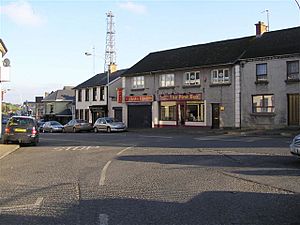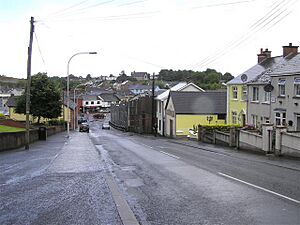1997 Coalisland attack facts for kids
Quick facts for kids 1997 Coalisland attack |
|||||||
|---|---|---|---|---|---|---|---|
| Part of the Troubles and Operation Banner | |||||||
 Coalisland approaching from the east, with the former RUC base's radio masts in the background |
|||||||
|
|||||||
| Belligerents | |||||||
Coalisland residents |
|||||||
| Strength | |||||||
| 2 IRA members | 12 SAS soldiers | ||||||
| Casualties and losses | |||||||
| 1 suspect wounded | None | ||||||
| 2 civilians wounded by the RUC | |||||||
On the evening of March 26, 1997, an event happened in Coalisland, County Tyrone, Northern Ireland. The Provisional Irish Republican Army (IRA), a group that wanted Northern Ireland to be part of the Republic of Ireland, attacked a police and army base. They used a homemade grenade. After the explosion, a secret unit of the British Army called the Special Air Service (SAS) quickly reacted. They shot and injured a young man named Gareth Doris. Soon, a crowd of people gathered and surrounded the SAS soldiers. This stopped the soldiers from getting to Doris or leaving the area. Police officers from the Royal Ulster Constabulary (RUC) then arrived. They fired plastic bullets at the crowd, which allowed the SAS soldiers to leave.
Contents
What happened before in Coalisland?
Coalisland is a town with a history of strong support for Irish republicanism. Before a ceasefire in 1994, five local people had been killed by British security forces.
Past incidents in the town
In February 1992, four IRA members died in a gunfight with the SAS. This happened as they tried to escape after attacking the RUC/British Army barracks. Three months later, in May 1992, the IRA attacked a British Army patrol. A soldier lost his legs. This led to fights between local people and British soldiers on May 12 and 17. Several civilians and soldiers were hurt. Some British army equipment was also damaged or stolen. After these clashes, about 500 people protested in the town. There were also strong disagreements between officials from the Republic of Ireland and Britain. More small fights between civilians and soldiers were reported in Coalisland on March 6, 1994.
The attack on the RUC base
The grenade attack
At 9:40 PM on Wednesday, March 26, 1997, a grenade was thrown at the shared British Army and RUC base in Coalisland. The explosion made a hole in the fence around the base. Police reported that a 1-kilogram device hit the fence about 3 meters off the ground. Another report said the device was a coffee-jar bomb filled with a type of explosive called Semtex. Two unknown men threw or fired the grenade. At the time, an art show was happening nearby at Coalisland Heritage Hall. People there clearly heard the explosion and the gunshots that followed. The whole event lasted only one to two minutes.
Secret army operation
Just one minute after the grenade attack, people nearby heard bullets flying past them. Several men, who seemed to be SAS soldiers, got out of regular cars. They wore baseball caps with "Army" written on them. These men were firing pistols and sub-machine guns. Witnesses said they heard eight to ten gunshots. Another report claimed up to 18 shots were fired. Gareth Doris, who was 19 years old, was shot in the stomach and fell down. It was said that Doris was coming back from the local church with a priest when he was shot. A local priest, Seamus Rice, was driving out of the church car park when bullets hit his car, breaking the windscreen.
Three minutes after the explosion, hundreds of angry local people gathered. They faced the secret soldiers. The soldiers fired live bullets at the ground and into the air to keep people away. The crowd kept moving back and then forward again. At 9:50 PM, the RUC police arrived. They started firing plastic bullets at the protesters. Two women were injured by these plastic bullets. The secret soldiers then quickly left in unmarked cars. As they left, they set off firecrackers or fireworks. A local politician, Francie Molloy, said that the protesters made the SAS leave. He believed this saved Gareth Doris's life. Witnesses claimed they feared a secret soldier with a pistol might have shot the injured Doris in the head.
After this, hundreds of local people had to leave their homes. Security forces searched the area near the base. This made the situation very tense, according to local activist Bernadette McAliskey. Later, two men were questioned by the RUC about the attack.
What happened next?
This attack, along with two large bombings in England on the same day, made people worry. They thought the IRA was trying to influence the upcoming UK general election. Martin McGuinness, a republican leader, called the shooting "murderous." Another local politician, Jim Canning, said that more than a dozen soldiers "were threatening to shoot anybody who moved [...] while a young man lay shot on the ground." Some republican groups said this was another example of a "shoot-to-kill policy" by the security forces. However, Ken Maginnis, a politician from the Ulster Unionist Party, praised the SAS for what they did.
Gareth Doris was taken to South Tyrone Hospital. After surgery, he was arrested. He was later moved to a military hospital in Belfast. Doris was later found guilty of being involved in the bombing. He was sentenced to ten years in prison. However, he was released in 2000 because of the Good Friday Agreement, a peace deal. Gareth was related to Tony Doris, an IRA member who was killed by the SAS in 1991. He is also a cousin of Michelle O'Neill, a leader in the Sinn Féin political party. According to Brendan Doris, another cousin, Gareth "absolutely denies being involved in terrorist activity of any description." Amnesty International, a human rights group, was concerned about the shooting. They noted that no warning was given before Doris was shot.
In 2015, police arrested Paul Campbell from Coalisland. This happened because DNA evidence from the shooting area linked him to the event. He was accused of being the other man with Doris during the attack. In February 2020, Campbell was found guilty by a special court in Belfast. Campbell said he was innocent, but he was sentenced to seven and a half years in prison. The prosecutor said that Campbell would have been released by then under the Good Friday Agreement. However, they argued that this decision was for the parole board, not the court.
On July 5, 1997, the British Army/RUC base was attacked again. An IRA member shot at an armored police vehicle next to the barracks. One female officer was injured. The former RUC police station in Coalisland finally closed in 2006. It was sold for private building in 2010.
See also
- Chronology of Provisional Irish Republican Army actions (1990–1999)
- Provisional IRA East Tyrone Brigade
- 1992 Coalisland riots
- Clonoe ambush


